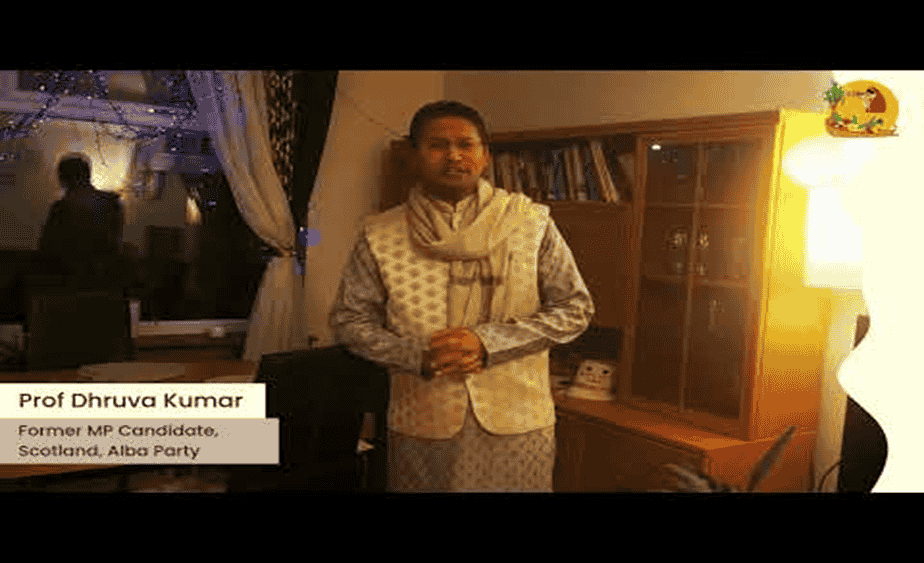- November 7, 2024
Chhath Parv: A Celebration of Devotion, Nature, and Community

A Special Message from Prof. Dhruva Kumar
In the video message, Prof. Dhruva Kumar shares a heartfelt message, expressing his admiration for the devotion of Chhath Parv observers around the world. He encourages the younger generation, especially those in the diaspora, to cherish and continue these traditions. Prof. Kumar reflects on the unity that Chhath brings, connecting us with our roots and with each other across continents.
“Chhath Parv is not just about rituals,” he says. “It’s about gratitude, resilience, and the enduring spirit of our people. I invite everyone, whether familiar with the festival or not, to experience its warmth and devotion. May Chhathi Maa and the Sun God bless all of us with health, happiness, and togetherness.”
Every year, as the coolness of autumn sets in, communities from Bihar and beyond come together to celebrate Chhath Parv, one of the most meaningful and vibrant festivals in our cultural calendar. Growing up, I witnessed the deep reverence with which my family and neighbours observed this festival. It is a unique occasion that connects us with nature, our ancestors, and, most importantly, with each other. While many festivals have complex rituals, none carry quite the same raw, heartfelt devotion as Chhath Parv.
Chhath Parv is a festival dedicated to Surya (the Sun God) and his sister, Chhathi Maa. The sun, an essential life force, has been worshipped for thousands of years, and this festival is our way of expressing gratitude for its energy and sustenance. For many, it’s more than just a tradition; it’s a personal journey and an offering of love and humility to the forces that nourish life.
The festival is known for its simplicity and intensity. There are no grand idols, no lavish decorations—only pure, devoted worship to the sun and Chhathi Maa. It’s celebrated in the open, with rituals carried out near water, reflecting an ancient bond between humanity and nature that stretches back to the Vedic ages.
Chhath Parv spans four days, each filled with devotion, purification, and community spirit. It’s not an easy festival to observe—there is fasting, discipline, and physical endurance involved—but for those who take part, it’s a way of rejuvenating the soul and expressing profound gratitude.
- Nahai-Khai (First Day): On the first day, devotees (often women, known as Vratis) begin by purifying themselves with a holy bath, often in the Ganges. A simple meal is prepared and shared with family, marking the start of a spiritual cleansing. It’s a humble beginning, yet it sets the tone for the inner journey that follows.
- Kharna (Second Day): On this day, the Vratis fast from sunrise to sunset, not even allowing themselves a sip of water. It’s a day of reflection and inner strength, culminating in an evening meal of kheer (sweet rice pudding) and roti, shared with family and community. This meal, offered to Chhathi Maa, is both a blessing and a reward for the day’s endurance.
- Sandhya Arghya (Third Day): As the sun begins to set on the third day, devotees gather at rivers, ponds, or any water source, holding fruits, sweets, and lamps as offerings. Standing in water, they raise their hands to the sun, chanting prayers in one of the most visually stunning parts of the festival. This ritual, known as “Sandhya Arghya,” honors the setting sun, thanking it for life’s many blessings. The sight of hundreds of glowing lamps and hopeful faces against the evening sky is unforgettable.
- Usha Arghya (Fourth Day): On the final day, devotees return to the water at dawn to greet the rising sun, offering prayers for health, prosperity, and happiness. This is a joyful moment, as families come together in celebration, breaking the fast and sharing the blessings of the festival. It’s a day filled with gratitude and joy, as the Vratis finally take sustenance, surrounded by family.
For those who observe Chhath Parv, it is more than just a religious duty. Take Shanti Devi, for example, a grandmother in Patna who has kept the tradition alive for over four decades. Every year, regardless of the weather or her health, she stands in the water, fasting and praying for the well-being of her family. Her commitment inspires everyone around her. “This is my way of showing gratitude to Chhathi Maa and the Sun God,” she says. And indeed, her family looks forward to this time, gathering from far and wide to be together for Chhath.
For many younger people who have moved abroad, Chhath Parv is a cherished connection to their roots. Aditi, a Bihari woman living in Scotland, finds the festival a comfort and a reminder of home. “Celebrating Chhath here keeps me connected to my family and traditions,” she explains. Though the setting may be different, the devotion remains unchanged, creating a small piece of Bihar in Scotland every year.
Dhruva Kumar adds, Biharis around the world carry their traditions with them, and Chhath Parv is no exception. From London to Melbourne, people come together to celebrate, often adapting the rituals to their surroundings. In cities without access to rivers, devotees may gather around pools or even large containers of water, improvising with whatever they can find. The essence remains the same, as families and friends unite to honour the sun and celebrate the festival with the same intensity.
Social media has also become a bridge, allowing families separated by distance to share in each other’s celebrations through live streams and videos. Chhath Parv has become a cultural event that goes beyond borders, with friends from other backgrounds joining in to witness and celebrate. The sense of unity and pride is evident, a reminder of how tradition can thrive even in new lands.
Chhath Parv is a celebration of life, gratitude, and resilience. For those who observe it, the festival is a profound reminder of the power of devotion and community. There’s something inspiring about watching Vratis endure fasting, standing in the cold water at dawn, with palms raised to the sky in humble prayer. This is faith at its most beautiful—simple, enduring, and powerful.
In a world that often moves too quickly, Chhath Parv offers a chance to slow down, to connect with nature, family, and tradition. It is a festival that transcends generations, cultures, and borders, uniting people in a shared moment of humility and hope. As the sun rises and sets on the final day, and the fast is broken with family by your side, there is a feeling of peace and completeness that can’t quite be put into words. Chhath Parv is a cherished piece of Bihari identity, one that connects us all, no matter where we are in the world.
Watch on youtube-https://youtu.be/lSTVLowX3mM


